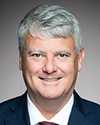I'll add some stuff to the two comments made.
Sault Ste. Marie itself has an excellent high-speed Internet connection, some top stuff. We have the Ontario Lottery and Gaming Corporation, which is a huge backbone there. I was able to do my presentation virtually to the commission. I pointed out to them as well that if you drive north of Sault Ste. Marie towards Wawa, Internet and cell service are non-existent in most places. That highway is closed so many times in the winter—if anybody has ever driven across Highway 17—and not for hours but for days sometimes. It's about fairness, it's about equity and it's about representation. I draw that...not only in the winter but for all of northern Ontario.
There are highway collisions. It's not a four-lane highway; it's a two-lane highway. Highway collisions with wildlife take a lot of lives, and it's very unfortunate.
By creating less representation that's going down, it's forcing, as the other two speakers have mentioned, people to drive and travel more. That's a safety issue. It's also an issue about equity—being rich versus poverty. Some people can afford a satellite connection, but in many places in northern Ontario, it's very difficult to get because of the storms and it's unreliable. My point is that it's about equity, and taking a seat away is not proper.
The biggest problem is that we're comparing northern Ontario to southern Ontario, which has been mentioned by Mr. Serré. It's about population. However, northern Ontario has more in common, probably, with northern Quebec, northern Saskatchewan, northern Alberta and all the north regions. There, the commission applies different mathematical formulas. Wherever you live in this great country, you should be treated the same.

